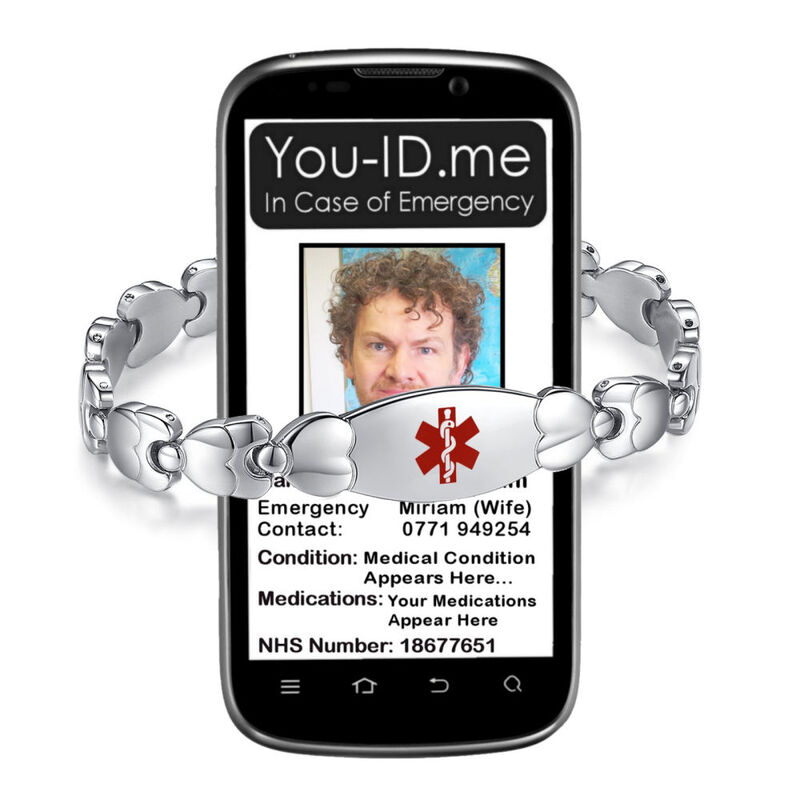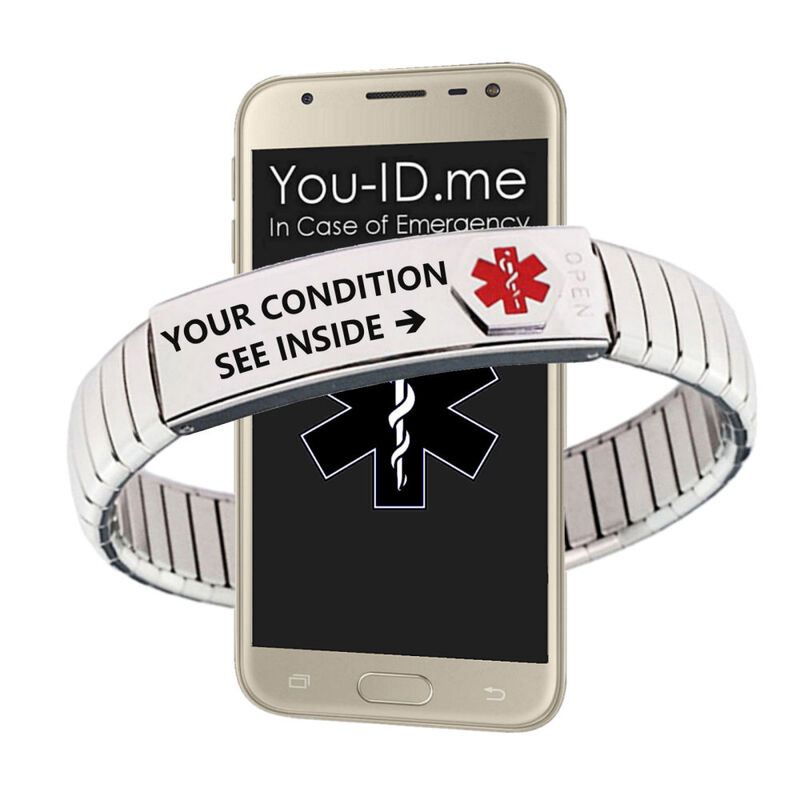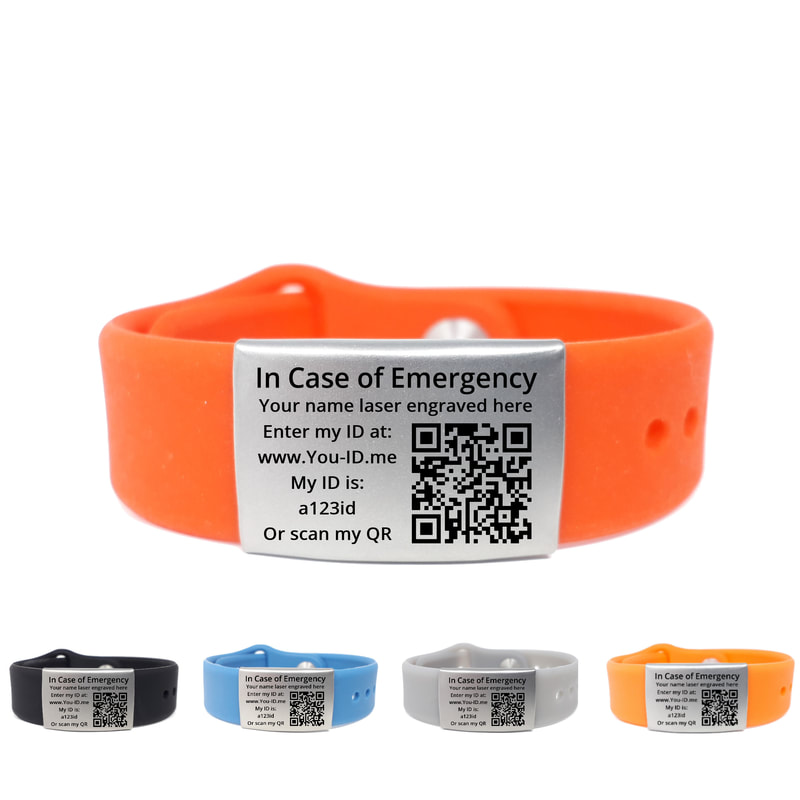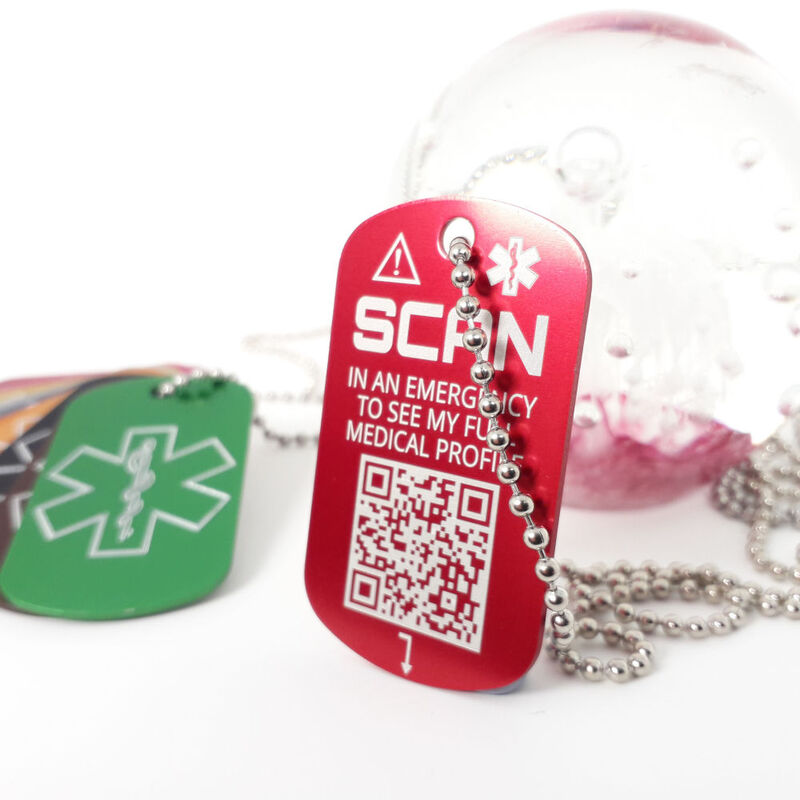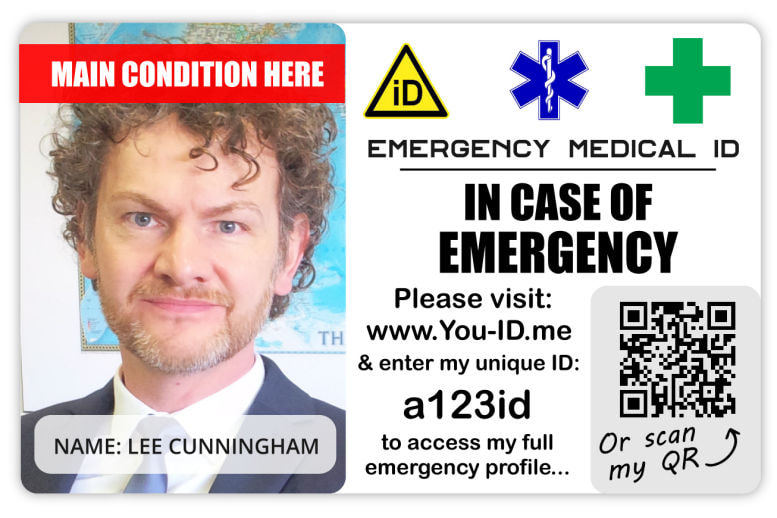|
Looking for Effective Medical ID in BathIf you're in Bath looking for medical ID bracelets, necklaces (jewellery) or medical cards or badges STOP!
Before you buy a medical alert bracelet, necklace, tag, card or badge, have you heard of the "You ID Me" service? "You ID Me" is the UK's leading emergency ID and alert service, providing paramedics and first responders with instant access to your vital ID, critical medical info and your emergency contacts' details, to the screen of their device directly from your medical ID product.
Popular in Bath : Medical ID - Mens & Ladies Bracelets, Necklaces & Cards"You ID Me" can also alert your emergency contacts phone to let them know you have a problem. Plus it can share with them the contact details of the paramedic treating you whether that's in Bath or elsewhere.
With "You ID Me" there's no more waiting for a knock at the door for your family members. All "You ID Me" medical alert products have you and your family covered... ...and the best thing is, it's available to you in Bath. It's now possible to order and buy medical ID bracelets, necklaces, tags or cards in Bath that have "You ID Me" built into them, so that if you have a medical emergency, the first responder that helps you will can quickly and easily get all your vital information - straight to the screen of their mobile device.
That means they can start giving you better emergency care sooner. |
VideosWatch a "You ID Me" Explainer Video...
Watch a 60 Second Demonstration of "You ID Me" in Action...
Listen to Speak4me Talking to Paramedics...
|
How Medical ID Products Work with "You ID Me"
|
Every one of our emergency medical ID products are either engraved or printed with a unique ID which becomes yours.
Users activate their unique ID by registering the information they 'd like to be shared in case of emergency. Registration is quick and easy. "You ID Me" has two service plans. Gold and Platinum: -
When you wear or carry a medical alert product from "You ID Me" in Bath three key things can happen in an emergency: -
* Platinum plan subscribers only |
Local delivery right across the UKBest Selling Medical ID |
Covering EVERY Medical Condition in Bath:
We create medical ID products for every medical condition that you can think of, and some that you'd struggle to think of! No one in Bath is completely immune to any medical condition which is why we've created a range of medical alert bracelets, emergency ID necklaces and photo medical cards that cover every medical condition possible, here are just a few with a short summary of what each is: -
1. Asthma: Chronic respiratory condition, inflammation.
2. Diabetes: Metabolic disorder, glucose regulation failure.
3. Hypertension: Persistently high blood pressure.
4. Osteoarthritis: Degenerative joint disease, pain.
5. Depression: Mood disorder, persistent sadness.
6. Migraine: Severe headache disorder, neurological.
7. Rheumatoid Arthritis: Autoimmune joint inflammation, chronic.
8. Heart Disease: Cardiovascular system dysfunction, various.
9. Epilepsy: Neurological disorder, recurrent seizures.
10. Chronic Kidney Disease: Gradual loss of kidney function.
11. Anxiety Disorders: Persistent, excessive fear or worry.
12. Bipolar Disorder: Mood disorder, extreme mood swings.
13. Alzheimer’s Disease: Progressive neurodegenerative disease, memory loss.
14. Parkinson’s Disease: Neurodegenerative disorder, movement difficulties.
15. Schizophrenia: Mental disorder, impaired thought processes.
16. Chronic Obstructive Pulmonary Disease (COPD): Chronic inflammatory lung disease, airflow blockage.
17. Irritable Bowel Syndrome (IBS): Gut disorder, pain, bloating, diarrhoea.
18. Celiac Disease: Autoimmune disorder, gluten intolerance.
19. Crohn’s Disease: Inflammatory bowel disease, chronic inflammation.
20. Ulcerative Colitis: Chronic inflammatory bowel disease, ulcers.
21. Multiple Sclerosis: Autoimmune disease, central nervous system.
22. Psoriasis: Skin disease, rapid skin cell production.
23. Lupus: Autoimmune disease, affects multiple organs.
24. Acne: Skin condition, oil glands infection.
25. Eczema: Skin condition, inflammation, itchiness.
26. Gout: Arthritic condition, uric acid crystals.
27. Chronic Fatigue Syndrome: Long-term fatigue, pain, without cause.
28. Fibromyalgia: Widespread musculoskeletal pain, fatigue, sleep.
29. Lyme Disease: Tick-borne illness, bacterial infection.
30. HIV/AIDS: Virus attacking immune system, chronic.
31. Hepatitis: Inflammation of the liver, viral.
32. Tuberculosis: Infectious disease, affects lungs primarily.
33. Malaria: Mosquito-borne infectious disease, parasites.
34. Dengue Fever: Mosquito-borne viral illness, severe flu-like.
35. Zika Virus: Mosquito-borne viral disease, birth defects.
36. Chikungunya: Mosquito-borne viral disease, joint pain.
37. Osteoporosis: Bone disease, decreased density, fragile.
38. Sickle Cell Disease: Genetic blood disorder, misshapen red cells.
39. Haemophilia: Blood clotting disorder, excessive bleeding.
40. Anaemia: Blood disorder, lack of red cells.
41. Thyroid Disorders: Thyroid gland dysfunction, hormonal imbalance.
42. Adrenal Insufficiency: Adrenal glands produce insufficient hormones.
43. Pancreatitis: Inflammation of the pancreas, painful.
44. Gallstones: Hardened deposits in the gallbladder.
45. Appendicitis: Inflammation of the appendix, acute.
46. Meningitis: Inflammation of brain and spinal cord membranes.
47. Encephalitis: Inflammation of the brain, infection or autoimmune.
48. Polycystic Ovary Syndrome (PCOS): Hormonal disorder, women, cysts on ovaries.
49. Endometriosis: Tissue similar to uterine lining grows outside uterus.
50. Prostate Enlargement: Benign prostatic hyperplasia, urinary problems.
51. Erectile Dysfunction: Inability to maintain an erection, sexual dysfunction.
52. Premenstrual Syndrome (PMS): Symptoms before menstruation, physical and emotional.
53. Menopause: End of menstrual cycles, women, hormonal changes.
54. Infertility: Inability to conceive after one year of trying.
55. Cystic Fibrosis: Genetic disorder, affects lungs and digestive system.
56. Pulmonary Fibrosis: Lung disease, scarred and damaged tissue.
57. Legionnaires’ Disease: Bacterial lung infection, severe pneumonia.
58. Pertussis (Whooping Cough): Highly contagious bacterial infection, severe coughing.
59. Scarlet Fever: Bacterial illness, rash, fever.
60. Chickenpox: Viral infection, itchy rash, blisters.
61. Measles: Viral infection, rash, fever, highly contagious.
62. Rubella (German Measles): Viral infection, rash, mild fever.
63. Influenza (Flu): Viral infection, respiratory symptoms, fever.
64. Common Cold: Viral respiratory infection, mild symptoms.
65. Bronchitis: Inflammation of the bronchial tubes, cough.
66. Sinusitis: Inflammation of the sinuses, congestion.
67. Otitis Media: Middle ear infection
68. Otitis Externa: Outer ear infection, swimmer's ear.
69. Conjunctivitis: Eye infection or allergy, pink eye.
70. Cataracts: Clouding of the eye's lens, vision loss.
71. Glaucoma: Eye condition, increased pressure, vision damage.
72. Macular Degeneration: Eye disease, loss of central vision.
73. Diabetic Retinopathy: Diabetes complication, eye damage.
74. Dry Eye Syndrome: Eyes don't produce enough tears, discomfort.
75. Uveitis: Inflammation of the uvea, eye swelling.
76. Keratoconus: Cornea thins and bulges, vision distortion.
77. Strabismus: Misaligned eyes, lack of coordination.
78. Amblyopia: Lazy eye, reduced vision.
79. Tinnitus: Ringing or buzzing noise in ears.
80. Hearing Loss: Partial or total inability to hear.
81. Vertigo: Sensation of spinning, balance disorder.
82. Anorexia Nervosa: Eating disorder, extreme weight loss.
83. Bulimia Nervosa: Eating disorder, bingeing and purging.
84. Binge Eating Disorder: Frequent overeating, lack of control.
85. Obesity: Excess body fat, health risk.
86. Malnutrition: Lack of proper nutrition, health decline.
87. Vitamin D Deficiency: Insufficient vitamin D, bone weakness.
88. Iron Deficiency Anaemia: Lack of iron, reduced red blood cells.
89. Scurvy: Vitamin C deficiency, bleeding, weakness.
90. Rickets: Vitamin D deficiency in children, bone softening.
91. Osteomalacia: Soft bones, vitamin D deficiency in adults.
92. Hyperthyroidism: Overactive thyroid, excessive hormone production.
93. Hypothyroidism: Underactive thyroid, insufficient hormone production.
94. Addison’s Disease: Adrenal insufficiency, cortisol deficiency.
95. Cushing's Syndrome: Excess cortisol, hormonal imbalance.
96. Polycystic Kidney Disease: Kidneys develop multiple cysts, function decline.
97. Urinary Tract Infection: Infection in urinary system, painful urination.
98. Kidney Stones: Hard deposits in kidneys, urinary pain.
99. Bladder Cancer: Cancer in bladder, blood in urine.
100. Prostate Cancer: Cancer in prostate gland, urinary issues.
2. Diabetes: Metabolic disorder, glucose regulation failure.
3. Hypertension: Persistently high blood pressure.
4. Osteoarthritis: Degenerative joint disease, pain.
5. Depression: Mood disorder, persistent sadness.
6. Migraine: Severe headache disorder, neurological.
7. Rheumatoid Arthritis: Autoimmune joint inflammation, chronic.
8. Heart Disease: Cardiovascular system dysfunction, various.
9. Epilepsy: Neurological disorder, recurrent seizures.
10. Chronic Kidney Disease: Gradual loss of kidney function.
11. Anxiety Disorders: Persistent, excessive fear or worry.
12. Bipolar Disorder: Mood disorder, extreme mood swings.
13. Alzheimer’s Disease: Progressive neurodegenerative disease, memory loss.
14. Parkinson’s Disease: Neurodegenerative disorder, movement difficulties.
15. Schizophrenia: Mental disorder, impaired thought processes.
16. Chronic Obstructive Pulmonary Disease (COPD): Chronic inflammatory lung disease, airflow blockage.
17. Irritable Bowel Syndrome (IBS): Gut disorder, pain, bloating, diarrhoea.
18. Celiac Disease: Autoimmune disorder, gluten intolerance.
19. Crohn’s Disease: Inflammatory bowel disease, chronic inflammation.
20. Ulcerative Colitis: Chronic inflammatory bowel disease, ulcers.
21. Multiple Sclerosis: Autoimmune disease, central nervous system.
22. Psoriasis: Skin disease, rapid skin cell production.
23. Lupus: Autoimmune disease, affects multiple organs.
24. Acne: Skin condition, oil glands infection.
25. Eczema: Skin condition, inflammation, itchiness.
26. Gout: Arthritic condition, uric acid crystals.
27. Chronic Fatigue Syndrome: Long-term fatigue, pain, without cause.
28. Fibromyalgia: Widespread musculoskeletal pain, fatigue, sleep.
29. Lyme Disease: Tick-borne illness, bacterial infection.
30. HIV/AIDS: Virus attacking immune system, chronic.
31. Hepatitis: Inflammation of the liver, viral.
32. Tuberculosis: Infectious disease, affects lungs primarily.
33. Malaria: Mosquito-borne infectious disease, parasites.
34. Dengue Fever: Mosquito-borne viral illness, severe flu-like.
35. Zika Virus: Mosquito-borne viral disease, birth defects.
36. Chikungunya: Mosquito-borne viral disease, joint pain.
37. Osteoporosis: Bone disease, decreased density, fragile.
38. Sickle Cell Disease: Genetic blood disorder, misshapen red cells.
39. Haemophilia: Blood clotting disorder, excessive bleeding.
40. Anaemia: Blood disorder, lack of red cells.
41. Thyroid Disorders: Thyroid gland dysfunction, hormonal imbalance.
42. Adrenal Insufficiency: Adrenal glands produce insufficient hormones.
43. Pancreatitis: Inflammation of the pancreas, painful.
44. Gallstones: Hardened deposits in the gallbladder.
45. Appendicitis: Inflammation of the appendix, acute.
46. Meningitis: Inflammation of brain and spinal cord membranes.
47. Encephalitis: Inflammation of the brain, infection or autoimmune.
48. Polycystic Ovary Syndrome (PCOS): Hormonal disorder, women, cysts on ovaries.
49. Endometriosis: Tissue similar to uterine lining grows outside uterus.
50. Prostate Enlargement: Benign prostatic hyperplasia, urinary problems.
51. Erectile Dysfunction: Inability to maintain an erection, sexual dysfunction.
52. Premenstrual Syndrome (PMS): Symptoms before menstruation, physical and emotional.
53. Menopause: End of menstrual cycles, women, hormonal changes.
54. Infertility: Inability to conceive after one year of trying.
55. Cystic Fibrosis: Genetic disorder, affects lungs and digestive system.
56. Pulmonary Fibrosis: Lung disease, scarred and damaged tissue.
57. Legionnaires’ Disease: Bacterial lung infection, severe pneumonia.
58. Pertussis (Whooping Cough): Highly contagious bacterial infection, severe coughing.
59. Scarlet Fever: Bacterial illness, rash, fever.
60. Chickenpox: Viral infection, itchy rash, blisters.
61. Measles: Viral infection, rash, fever, highly contagious.
62. Rubella (German Measles): Viral infection, rash, mild fever.
63. Influenza (Flu): Viral infection, respiratory symptoms, fever.
64. Common Cold: Viral respiratory infection, mild symptoms.
65. Bronchitis: Inflammation of the bronchial tubes, cough.
66. Sinusitis: Inflammation of the sinuses, congestion.
67. Otitis Media: Middle ear infection
68. Otitis Externa: Outer ear infection, swimmer's ear.
69. Conjunctivitis: Eye infection or allergy, pink eye.
70. Cataracts: Clouding of the eye's lens, vision loss.
71. Glaucoma: Eye condition, increased pressure, vision damage.
72. Macular Degeneration: Eye disease, loss of central vision.
73. Diabetic Retinopathy: Diabetes complication, eye damage.
74. Dry Eye Syndrome: Eyes don't produce enough tears, discomfort.
75. Uveitis: Inflammation of the uvea, eye swelling.
76. Keratoconus: Cornea thins and bulges, vision distortion.
77. Strabismus: Misaligned eyes, lack of coordination.
78. Amblyopia: Lazy eye, reduced vision.
79. Tinnitus: Ringing or buzzing noise in ears.
80. Hearing Loss: Partial or total inability to hear.
81. Vertigo: Sensation of spinning, balance disorder.
82. Anorexia Nervosa: Eating disorder, extreme weight loss.
83. Bulimia Nervosa: Eating disorder, bingeing and purging.
84. Binge Eating Disorder: Frequent overeating, lack of control.
85. Obesity: Excess body fat, health risk.
86. Malnutrition: Lack of proper nutrition, health decline.
87. Vitamin D Deficiency: Insufficient vitamin D, bone weakness.
88. Iron Deficiency Anaemia: Lack of iron, reduced red blood cells.
89. Scurvy: Vitamin C deficiency, bleeding, weakness.
90. Rickets: Vitamin D deficiency in children, bone softening.
91. Osteomalacia: Soft bones, vitamin D deficiency in adults.
92. Hyperthyroidism: Overactive thyroid, excessive hormone production.
93. Hypothyroidism: Underactive thyroid, insufficient hormone production.
94. Addison’s Disease: Adrenal insufficiency, cortisol deficiency.
95. Cushing's Syndrome: Excess cortisol, hormonal imbalance.
96. Polycystic Kidney Disease: Kidneys develop multiple cysts, function decline.
97. Urinary Tract Infection: Infection in urinary system, painful urination.
98. Kidney Stones: Hard deposits in kidneys, urinary pain.
99. Bladder Cancer: Cancer in bladder, blood in urine.
100. Prostate Cancer: Cancer in prostate gland, urinary issues.
Delivering Medical ID in and Around Bath...
We supply and delivery medical ID products for ANY medical condition to men, women and children in and around Bath. Here's a list including the first few characters of our delivery postcodes: -
- Chippenham, SN14
- Frome, BA11
- Trowbridge, BA14
- Keynsham, BS31
- Bradford-on-Avon, BA15
- Radstock, BA3
- Midsomer Norton, BA3
- Shepton Mallet, BA4
- Melksham, SN12
- Corsham, SN13
- Devizes, SN10
- Warminster, BA12
- Calne, SN11
- Yate, BS37
Related Health Medical Information for Bath
The Health Index is an innovative tool designed to offer a comprehensive measure of health within different geographical regions, enabling insights into health dynamics over time. It provides a holistic view by incorporating various health-related topics, thereby highlighting the determinants influencing health changes. This index is particularly useful for comparing health outcomes across local, regional, and national scales. Currently focused on England, there's an ambition to expand its coverage to the entire UK.
In the case of Bath and North East Somerset, the area boasts a Health Index score of 114.8, indicating a notable improvement in health outcomes, with an increase of 2.7 points from the previous year. This score is above the baseline of 100 set in 2015, signaling better-than-average health conditions compared to the national average at that time. Among local authority areas in England, Bath and North East Somerset ranks within the top 20% for health in 2021, with particular strengths observed in the subdomain of "economic and working conditions".
The area excelled in the "economic and working conditions" subdomain with a score of 119.0, the highest across all subdomains. This aspect evaluates factors such as child poverty, employment training opportunities, unemployment rates, and workplace safety. Following closely is the "behavioural risk factors" subdomain, where Bath and North East Somerset also outperforms the national average, indicating a robust approach to addressing alcohol and drug misuse, dietary habits, physical activity, and smoking, among other factors.
Interestingly, there was a significant improvement in the "behavioural risk factors" from 2020 to 2021, with the area moving from the top 30% to the top 20% of local authority areas in England. This improvement was driven by reductions in sexually transmitted infections and smoking rates.
Additionally, the "living conditions" and "physiological risk factors" subdomains saw remarkable improvements over a six-year span, with Bath and North East Somerset showcasing advancements in reducing household overcrowding and air pollution, as well as managing high blood pressure and obesity rates among adults.
However, not all indicators within the Health Index were positive. The area recorded lower scores in "mental health" and "feelings of anxiety," pointing to areas that may require targeted interventions to improve overall health outcomes.
In summary, Bath and North East Somerset demonstrates strong health performance in several key areas, with particular strengths in economic conditions and behavioural risk factors. These findings not only reflect the area's commitment to enhancing the health and well-being of its residents but also highlight potential areas for further health promotion and disease prevention efforts.
In the case of Bath and North East Somerset, the area boasts a Health Index score of 114.8, indicating a notable improvement in health outcomes, with an increase of 2.7 points from the previous year. This score is above the baseline of 100 set in 2015, signaling better-than-average health conditions compared to the national average at that time. Among local authority areas in England, Bath and North East Somerset ranks within the top 20% for health in 2021, with particular strengths observed in the subdomain of "economic and working conditions".
The area excelled in the "economic and working conditions" subdomain with a score of 119.0, the highest across all subdomains. This aspect evaluates factors such as child poverty, employment training opportunities, unemployment rates, and workplace safety. Following closely is the "behavioural risk factors" subdomain, where Bath and North East Somerset also outperforms the national average, indicating a robust approach to addressing alcohol and drug misuse, dietary habits, physical activity, and smoking, among other factors.
Interestingly, there was a significant improvement in the "behavioural risk factors" from 2020 to 2021, with the area moving from the top 30% to the top 20% of local authority areas in England. This improvement was driven by reductions in sexually transmitted infections and smoking rates.
Additionally, the "living conditions" and "physiological risk factors" subdomains saw remarkable improvements over a six-year span, with Bath and North East Somerset showcasing advancements in reducing household overcrowding and air pollution, as well as managing high blood pressure and obesity rates among adults.
However, not all indicators within the Health Index were positive. The area recorded lower scores in "mental health" and "feelings of anxiety," pointing to areas that may require targeted interventions to improve overall health outcomes.
In summary, Bath and North East Somerset demonstrates strong health performance in several key areas, with particular strengths in economic conditions and behavioural risk factors. These findings not only reflect the area's commitment to enhancing the health and well-being of its residents but also highlight potential areas for further health promotion and disease prevention efforts.



